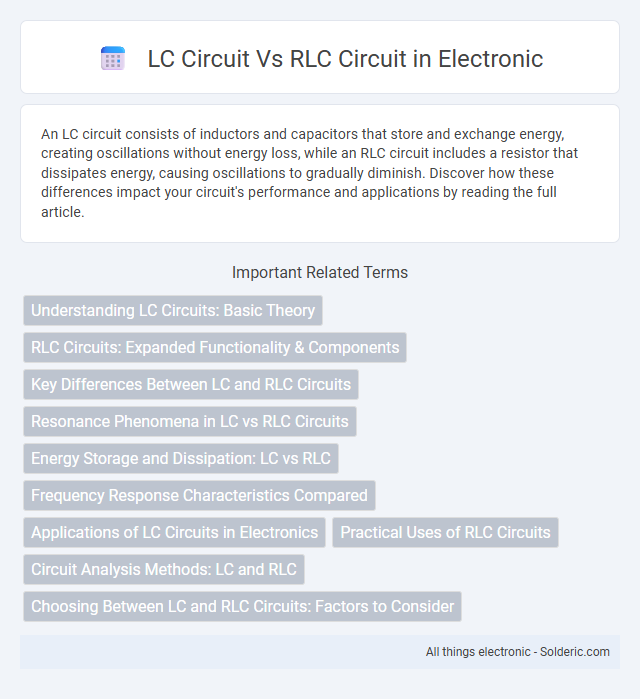An LC circuit consists of inductors and capacitors that store and exchange energy, creating oscillations without energy loss, while an RLC circuit includes a resistor that dissipates energy, causing oscillations to gradually diminish. Discover how these differences impact your circuit's performance and applications by reading the full article.
Comparison Table
| Feature | LC Circuit | RLC Circuit |
|---|---|---|
| Components | Inductor (L) and Capacitor (C) | Resistor (R), Inductor (L), and Capacitor (C) |
| Energy Loss | Negligible (idealized as lossless) | Energy dissipates due to resistance |
| Damping | No damping (ideal oscillation) | Damped oscillations based on resistance value |
| Resonant Frequency | f0 = 1 / (2p(LC)) | f0 1 / (2p(LC)) (adjusted for resistance) |
| Quality Factor (Q) | Infinite (ideal) | Finite, Q = (1/R)(L/C) |
| Applications | Ideal harmonic oscillators, filters, tuners | Realistic resonators, signal processing, damping control |
Understanding LC Circuits: Basic Theory
LC circuits consist of an inductor (L) and a capacitor (C) connected in series or parallel, creating a resonant system that stores energy alternately in magnetic and electric fields. The fundamental theory involves oscillations at the circuit's natural resonant frequency, defined by \( f_0 = \frac{1}{2\pi\sqrt{LC}} \), where energy transfers between the inductor's magnetic field and the capacitor's electric field without significant loss. Unlike RLC circuits, LC circuits do not include a resistor, resulting in idealized, undamped oscillations in voltage and current.
RLC Circuits: Expanded Functionality & Components
RLC circuits include a resistor (R), inductor (L), and capacitor (C), providing expanded functionality compared to simple LC circuits by enabling control over damping and resonance characteristics. The resistor introduces energy dissipation, allowing RLC circuits to model real-world systems with transient and steady-state behaviors more accurately. This combination results in tunable frequency responses and enhanced applications in filters, oscillators, and signal processing devices.
Key Differences Between LC and RLC Circuits
An LC circuit consists solely of an inductor and a capacitor, creating a pure oscillatory system with no energy dissipation, while an RLC circuit includes a resistor that introduces energy loss and damping effects. The resonance frequency in an LC circuit is ideal and determined only by inductance and capacitance, whereas in an RLC circuit, the resistance alters the resonance frequency and reduces the amplitude of oscillations. Energy in an LC circuit oscillates continuously between the magnetic field of the inductor and the electric field of the capacitor, but in an RLC circuit, part of this energy is lost as heat due to the resistor.
Resonance Phenomena in LC vs RLC Circuits
Resonance in an LC circuit occurs at a frequency where inductive reactance equals capacitive reactance, resulting in maximum voltage or current with minimal energy loss due to the absence of resistance. In contrast, an RLC circuit exhibits resonance with a bandwidth and quality factor influenced by the resistance, causing energy dissipation and a less sharp resonant peak. The presence of resistance in RLC circuits leads to damping effects, affecting the amplitude and phase response at the resonant frequency compared to the ideal behavior of LC circuits.
Energy Storage and Dissipation: LC vs RLC
An LC circuit stores energy oscillating between the inductor's magnetic field and the capacitor's electric field with minimal energy loss, resulting in sustained oscillations. In contrast, an RLC circuit includes a resistor that dissipates energy as heat, causing the oscillations to gradually decay over time. The presence of resistance in an RLC circuit leads to energy dissipation that affects the circuit's quality factor and damping behavior.
Frequency Response Characteristics Compared
LC circuits exhibit a sharp resonant frequency with minimal energy loss due to the absence of resistance, resulting in a high Q-factor and a narrow bandwidth. In contrast, RLC circuits introduce resistance, which dampens oscillations, broadens bandwidth, and lowers the Q-factor, thereby providing a more stable and controlled frequency response. The frequency response of RLC circuits is more versatile for practical applications requiring selective filtering and signal smoothing.
Applications of LC Circuits in Electronics
LC circuits are widely used in electronics for tuning and frequency selection in radio transmitters and receivers, enabling precise signal filtering and oscillation generation. These circuits form the backbone of oscillators in RF communication systems, where maintaining stable, resonant frequencies is critical. LC circuits also serve in impedance matching networks, enhancing signal transfer efficiency between components.
Practical Uses of RLC Circuits
RLC circuits, which include a resistor, inductor, and capacitor, are widely used in practical applications such as tuning radios, filtering signals, and managing frequency response in electronic devices. They enable precise control over resonance and damping, crucial for designing oscillators and frequency-selective networks. Your electronic projects benefit from RLC circuits' ability to stabilize voltage and reduce signal distortion in communication systems.
Circuit Analysis Methods: LC and RLC
LC circuit analysis primarily involves solving differential equations based on inductance (L) and capacitance (C) to determine natural oscillations and resonant frequency, typically using Kirchhoff's voltage law and impedance concepts. RLC circuit analysis expands on LC methods by incorporating resistance (R), which introduces damping effects, requiring solutions to second-order linear differential equations that account for transient and steady-state behavior. Frequency response, quality factor (Q), and damping ratio are key parameters analyzed in RLC circuits to evaluate energy loss and oscillation decay.
Choosing Between LC and RLC Circuits: Factors to Consider
When choosing between LC and RLC circuits, consider factors such as energy dissipation, frequency selectivity, and application requirements; LC circuits are ideal for low-loss oscillators due to zero resistance, while RLC circuits include resistance, allowing controlled damping and stabilization. Frequency response is sharper in LC circuits, meaning precise tuning, whereas RLC circuits provide a broader bandwidth and are better suited for practical filtering and signal processing applications. Stability under load variations and the need for phase shift or transient suppression also influence the circuit choice, with RLC circuits offering improved performance in real-world conditions.
LC circuit vs RLC circuit Infographic

 solderic.com
solderic.com